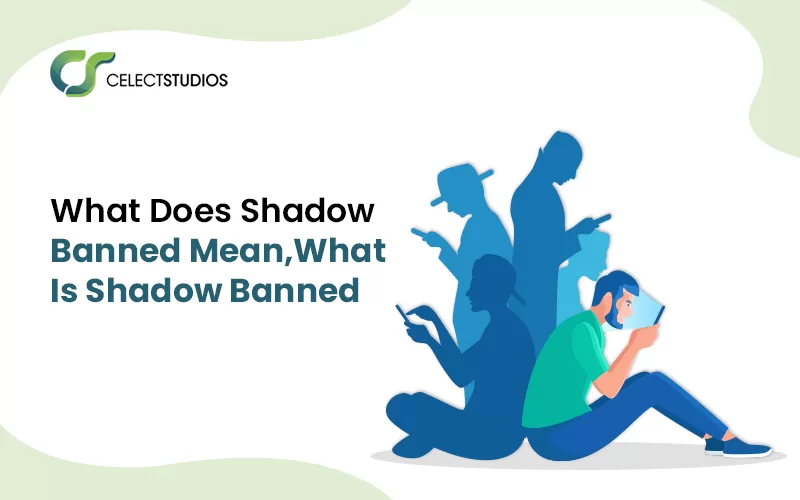What Does Shadow Banned Mean?
Shadow banning is a controversial practice utilized by online platforms to limit users’ visibility without informing them. To understand it more easily, think of it this way: Imagine you are at a mass gathering where everyone can see you. When you try to converse, no one responds to what you say. You attempt to make jokes and share stories but are only met with deafening silence instead of laughter or replies. You’re there, but you are not there for other guests. Therefore, your presence and contributions become futile. You are being ghosted. In other words, you are being shadow banned! Shadow banning occurs when your visibility or reach is restricted without your knowledge, making it seem like you are participating normally when, in reality, your interactions are being hidden or limited from others.
This technique is generally used to tackle issues like spam, abusive behavior, and other forms of misconduct while mitigating the potential for escalation or retaliation from the affected user. Despite its intentions, shadow banning has opened various cans of worms in the form of discussions surrounding transparency, censorship, and its broader impact on online conversations. Critic opinions have been somewhat mixed. While some argue it can effectively maintain a healthy online community, others highlight concerns about its transparency, censorship, and the stifling of dissenting voices. This debate has remained persistent over the years. It underscores the complex nature of content moderation in the age of digitalization, where platforms must balance the need for safety and civility with the principles of free speech and open dialogue. For instance, in the bustling tech landscape, a reputable mobile app development company in Chicago might grapple with similar challenges when developing and managing user-generated content platforms.
What Is Shadow Banned? How Does It Work?
When a user is shadow banned, their content is hidden from public view, effectively separating them from the general community. While the shadow banned user’s content is still visible to them, it does not appear in search results, feeds, or notifications for other users. This can result in a false impression that their content is being seen normally, further leading to confusion and frustration when the cat is out of the bag. This practice raises concerns about transparency and fairness, as users may be unaware of their restricted status and, therefore, unable to rectify the situation. Furthermore, critics argue that shadow banning can suppress free expression and hinder meaningful dialogue by silencing dissenting voices and limiting the diversity of viewpoints in online discussions.
Here’s how shadow banning typically works:
- Content Visibility: When a user is shadow banned, their posts, comments, or other content appear normal to them. They can see their content and interactions as if nothing is wrong. Everything seems to be in order.
- Invisible to Others: However, this content is invisible or difficult for other users to find. It won’t appear in search results, feeds, or notifications, making it seem like the shadow banned user is being blacklisted or their content is being neglected.
- Limited Reach: Shadow banning aims to limit the reach and impact of a user’s content without directly banning them. Think of it as sabotage. Disrupting the system from within without any outer signs of attack.
- Algorithmic Detection: Social media platforms often use algorithms to detect potentially problematic content or users. These algorithms can automatically shadow ban users based on certain criteria, such as their posting frequency, use of certain keywords, or behavior patterns.
- Manual Intervention: Moderators or administrators can also manually implement shadow banning in exceptional cases. They can selectively hide a user’s content without alerting them, which is usually done in response to repeated community guidelines violations.
- Effects on Engagement: Being shadow banned can significantly impact a user’s engagement and interaction with the platform. Since their content is effectively concealed from others, they may receive fewer clicks, likes, comments, or shares, thereby decreasing their overall reach and influence.
Examples of shadow banning can be seen across various platforms:
- Reddit: On Reddit, shadow banning is used to combat spam. Shadow banned users can continue to post, but their posts are automatically removed and remain concealed from others.
- Instagram: Instagram has been known to shadow ban accounts that violate its community guidelines, such as using AI bots for likes or comments. The targeted accounts may experience a significant decrease in engagement.
- Twitter: Twitter has faced criticism for allegedly shadow-banning conservative voices. Users have reported that their tweets are not visible in search results or under hashtags, which limits their reach.
Reasons for Shadow Banning
Social media and online forums often use shadow-banning to maintain positive community environments, including in Unreal game development. This strategy limits the visibility of problematic users, deterring behaviors like spam and harassment. Rather than outright bans, shadow banning encourages users to modify their behavior or seek assistance from moderators. This approach aims to cultivate healthier online interactions. By restricting visibility, shadow banning can reduce the impact of disruptive users without completely removing them from the platform. This nuanced approach helps platforms manage community standards and encourages constructive engagement among users.
There are several reasons why a user may be shadow banned:
- Violation of Community Guidelines: Users who repeatedly violate a platform’s community guidelines, such as by posting hate speech, spamming, or engaging in actions that are considered harassment, may shadow banned to reduce the impact of their behavior on the community.
- Automated Detection: Many platforms use automated systems to detect and flag suspicious or harmful activity. If a user’s activity triggers these systems, they may be shadow banned without any external intervention.
- Protecting Users: Shadow banning can safeguard users from harmful or offensive content. By limiting the visibility of banned users, platforms can limit the spread of misinformation, hate speech, and other harmful content.
- Reduce Spam: Shadow banning is often used to combat spam on social media and forums. By filtering out spam content, platforms can prevent it from cluttering the feed or forum.
- Encourage Positive Behavior: Some platforms use shadow banning to encourage users to adhere to community guidelines. By making the impact of violating the rules less visible, platforms hope to discourage such behavior.
- Avoiding Confrontation: In some cases, platforms may choose shadow banning to prevent confrontation with users who may react negatively to being banned outright. This approach enables the platform to maintain a sense of normalcy while still addressing the issue.
Criticisms of Shadow Banning
Though effective for moderation, shadow banning has faced criticism for its lack of transparency and potential for abuse. Critics argue that users should be informed when they are shadow banned to understand the reason and have a chance at appeal and redemption. Additionally, concerns arise regarding using shadow banning to suppress conflicting opinions or censor content, which could negate the principles of free speech and open dialogue.
Despite these criticisms, those in favor of shadow banning, such as in the recent controversy over the Activision appeal ban, believe that it can be a valuable tool for maintaining healthy online communities when used with caution. By limiting the visibility of problematic users, platforms can stop disruptive behaviors in their tracks without resorting to more severe measures, allowing users to continue engaging in the community. However, some platforms have implemented more transparent moderation practices or clearer user guidelines to address these concerns.
How to Tell if You’ve Been Shadow Banned
Detecting a shadow ban on social media platforms can feel like stumbling through a digital maze, as platforms rarely provide direct notifications about such actions. Instead, several subtle clues may suggest that you’ve been shadow banned:
- Engagement Metrics: Imagine the bustling marketplace of social media engagement suddenly falling silent. A shadow ban can result in fewer likes, comments, and shares on your posts, causing most of your previously popular content to be blacklisted and become invisible to users. The absence of these interactions can be a revealing sign that your content has been strangled.
- Hashtag Visibility: Hashtags are the signposts of social media, guiding users to discover new content. However, if your posts no longer appear in hashtag searches or explore pages, your content has become invisible to those looking for similar content. This limited visibility can severely restrict your reach and engagement, potentially giving you a hint that you have been imposed with a shadow ban.
- Test with Another Account: To confirm your suspicion, you can do this: Post content from another account or ask a friend to check if your posts are visible to them. If your content remains elusive to these fresh eyes, it’s strong proof that you’ve fallen victim to a shadow ban.
How to Avoid Being Shadow Banned
To reduce the risk of being shadow banned, it’s crucial to understand and strictly adhere to your platform’s community guidelines and terms of service. Here are some detailed tips to help you avoid falling into the shadowy realms of banishment:
- Authentic Engagement: Rather than chasing fleeting likes and comments, foster genuine connections and meaningful interactions with other users. Engage thoughtfully with their content, and avoid spammy tactics to artificially boost your visibility.
- Avoid Spammy Behavior: Avoid posting duplicate or irrelevant content, as this can trigger the platform’s spam filters and flag your account for potential shadow-banning. Also, refrain from using automated tools to generate posts, as the platform can often detect and penalize them.
- Comply with Guidelines: Take the time to familiarize yourself with the platform’s rules and guidelines, and ensure that your content aligns with these standards. Avoid posting content that is offensive, misleading, or violates any of the platform’s policies, as this can result in your account being shadow banned.
Conclusion
Shadow banning is a practice with advocates and critics that online platforms use to regulate user behavior and uphold community standards. This includes wearable app development. It has sparked debates over transparency, fairness, and censorship. Despite its potential effectiveness in keeping spam and abuse in check, there are still concerns regarding its impact on free expression. Nevertheless, by familiarizing themselves with shadow-banning mechanisms and following online conduct guidelines, users can actively maintain a transparent and inclusive online environment. This approach keeps their content’s visibility secure and promotes constructive engagement within the digital community.



